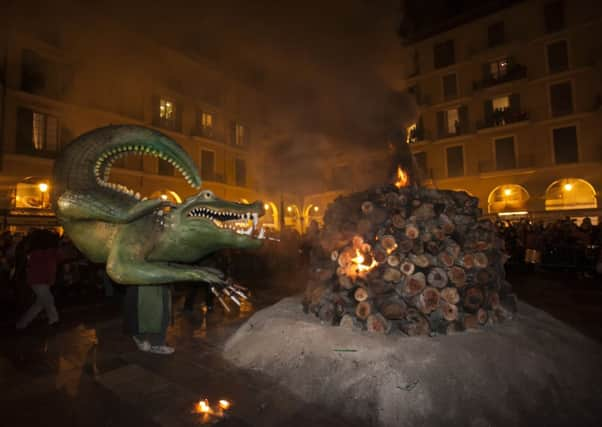Travel: Palma de Mallorca, Spain


“Aye, aye, aye. Madre de Dios,” a group of Spanish women yelped as a group of devils ran towards them brandishing pitchforks decorated with bats. The yelps quickly intensified into loud screams as one of the devils lit a Catherine Wheel on a pole and waved it around his horns, sending curtains of sparks raining down on their heads.
These marauding colles de dimonis (gangs of devils) are a highlight of the Fiesta Sant Sebastià, an anarchic 15-day festival of music and ancient traditions that in the depth of winter lights up the streets of Palma de Mallorca. For the locals, it’s an excuse to prolong the festive season. Whereas in the rest of Spain, Christmas decorations are torn down just after Epiphany, in Palma they keep them up for a few extra weeks, and for visitors looking to chase away the winter blues, there’s no better time to visit this feisty Mediterranean city.
Advertisement
Hide AdOn sunny winter days, Palma’s old city looks dazzling. The ancient buildings are built from honey-coloured local sandstone and the low angle of the sun illuminates the facades with an almost translucent pink glow. Arriving in the late afternoon, I made my way down to the cathedral which looks out over the sea on a dramatic bluff.
Outside the busy holiday season, a relaxed buzz hangs over Palma. For a few months the locals have time to enjoy their city free from throngs of tourists, and along the ramparts below the cathedral I joined joggers, dog walkers and family groups who were laughing and chatting as they enjoyed a crimson Mediterranean sunset. Night-time temperatures plummet quickly at this time of year, but in the many cafés lining the city’s plazas flickering gas fires provide welcome relief against the chill. At the simple Rustic Café in the romantic Placa d’en Coll I ordered some hot chocolate and churros – freshly fried doughnuts sprinkled with sugar.
Crispy on the outside and deliciously gooey on the inside, churros are the traditional rocket fuel for all-night partying in Spain.
By 10pm, crowds had started to gather in the city centre ahead of the Correfoc, a spectacular parade of firework-spewing beasts and devils. In the Catalan-speaking regions of Spain, similar parades take place throughout the year. They date from the Middle Ages when rowdy street plays depicting the struggle between good and evil were extremely popular.
The sense of anticipation was electric. In the distance, red and green fireworks lit up the rooftops and, silhouetted against the smoke, the jaws of a dinosaur-shaped float slowly came into view. Then all hell broke loose as the infamous dimonis, who resemble hoodies with horns, ran into the crowd, showering spectators with sparks. At this point a troupe of drummers on an outdoor stage struck up an infectious beat and, jumping onto the stage, the irrepressible dimonis kicked off the party with some very suggestive pole-dancing routines.
The next day a collective hangover permeated the city streets. Keen to enjoy the balmy winter sunshine, I wandered over to Santa Catalina, Palma’s old fishing port where three ancient windmills stand on a hill above a warren of pretty whitewashed cottages. Nowadays, Santa Catalina is Palma’s most popular café and bar district, but in the midday sunshine the streets were totally deserted.
Advertisement
Hide AdThere was slightly more life in Patron Lunares, an ex-fishermen’s social club. Packed with nostalgic fishing memorabilia, the club is now a popular restaurant specialising in Majorcan cuisine with Oriental and Latin American twists. I ordered some spicy langoustine fritters and prawns marinated in coconut, lime and wasabi – perfect wake-me-up food for a sleepy hangover.
The following evening, crowds once again gathered in Placa Major for another night of festivities. I arrived just as a parade of giant folklore figures began jigging around to the melodic strains of xeremies, traditional Majorcan bagpipes with a cheerful high-pitched range. The giants were followed by an effigy of the Drac de na Coca, a green crocodile-shaped dragon – legend has it that it once roamed Palma’s sewers terrorising the population. Now it’s the city’s beloved mascot.
Advertisement
Hide AdThe mayor of Palma then lit a giant bonfire, which was the cue for dozens of outdoor barbecues to begin. The streets quickly filled up with the delicious aroma of sizzling sobrassadas – paprika-spiced sausages unique to the Balearic Islands. With kids running around wearing glowing red horns and musicians strumming guitars on outdoor stages, a wonderful community feeling pervaded Palma’s streets during this final night of the fiesta. As I wandered around enjoying the good-natured atmosphere, I couldn’t think of a better way of brightening up a chilly winter’s night.
FACT FILE
• For more information on Palma, visit www.palmavirtual.es
• Neil Geraghty stayed at Hotel Jaime III (www.hmjaimeiii.com). Double rooms start from £81.
FOLLOW US
SCOTSMAN TABLET AND MOBILE APPS